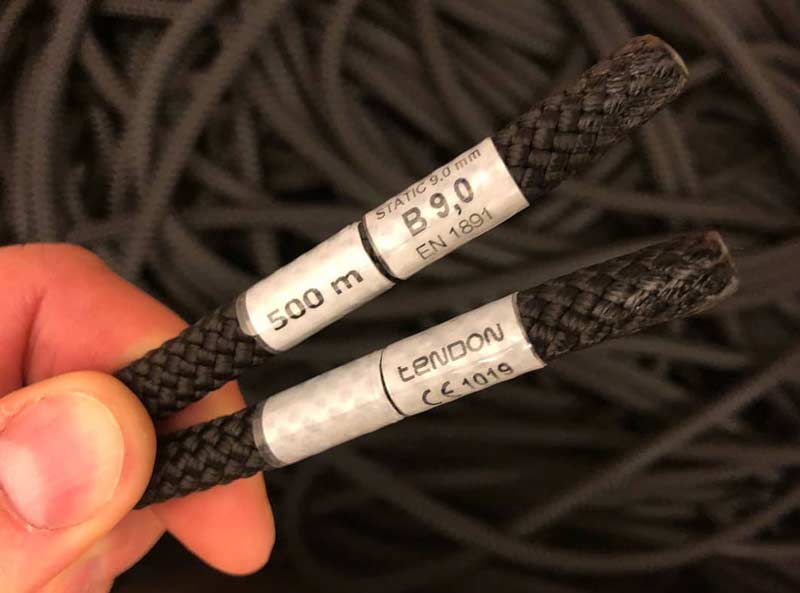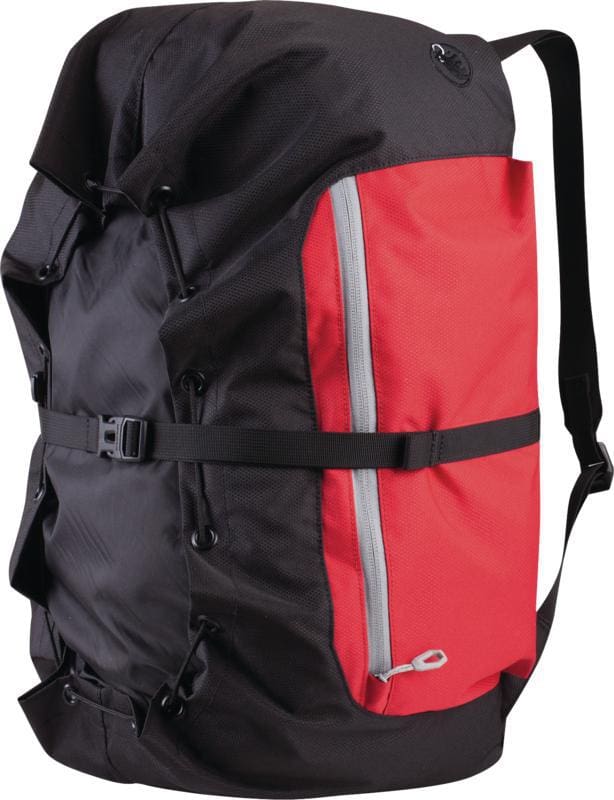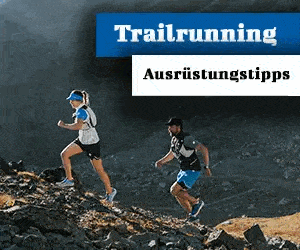The rope is next to carbines, harness and shoes probably the most important product of a climber and a climber. But which types of rope are there? How do I clean a rope? How long can I use my rope? These and other questions are answered in today's guest article Matthias Schmid, rope expert at Bächli Bergsport.
A contribution by Matthias Schmid - Bächli Bergsport
The rope is the life insurance for a rope team and represents one of the most safety-relevant products in mountain sports. Ropes are divided into different categories. These indicate the area of application for which the product is suitable.
Basic knowledge climbing ropes
Dynamic ropes are used for climbing. These have a high elasticity and can thus absorb the energy of a fall. Modern climbing ropes have a so-called core-sheath construction. The outer jacket protects against abrasion and environmental influences, while the inner core absorbs the fall energy. In the event of a fall, the individual fibers of the core are stretched. Without stress, the fibers then contract again. This shrinkage process can also result in a rope becoming shorter than specified. When assembling a rope, i.e. when cutting it to size, a climbing rope is therefore cut with a certain reserve. In this way a manufacturer can guarantee that his rope will reach the specified length in most situations. With ropes that have not been stretched for a long time, however, it can also happen that a rope is shorter than specified.
How long does the rope have to be for which use?
For purely indoor use, depending on the hall, only a shorter rope to 50m is required. Due to the intensive indoor use, ropes suffer more. Therefore, here is a slightly thicker and heavier rope with larger mantle portion makes sense. As soon as you want to use the rope outdoors as well, we recommend an impregnated model with a length from 60 to 70m. In most Plaisir climbing gardens, 50m ropes are sufficient. However, longer variants, eg when rappelling, have larger safety reserves. For double ropes we recommend a length from 60 to 70m.

You need to know about the care and wear of ropes
After each use, it should be checked with eyes and hands whether damage to the jacket or gross injuries are visible or noticeable. In the case of heavy coat damage or after hard falls, the rope must be replaced. To protect the rope from dirt, it is best to use one ropebag, Dirt particles inside can rub on the rope and stiffen it. If the rope is heavily soiled, it can be washed by hand with lukewarm water and a mild detergent (for synthetic fabrics). Then lay out the rope to dry in a loose state. Do not place the rope in the sun to dry or expose it to excessive heat.
Ropes age especially due to mechanical stress (knots and abrasion) and moisture.
A ten year old, little used rope has only 10% breaking load reduction. A one-year, but heavily worn rope (visually apparent), however, has a much stronger breaking load reduction. Mechanically injured ropes are completely unsuitable for further use. A rope is to be replaced immediately, if either the white core is visible, a clearly perceptible coat slip exists, the coat is very furry and worn out or strong superficial burns developed. These burns can be caused by rapid rappelling or by the friction on the express, which deflects the rope when falling. The "inner erosion" caused by small, penetrated grains of sand is particularly dangerous for the rope.
An ropebag offers the best protection against it. If the end of the rope is tied to the rope bag, it can not accidentally slip through the fuse when it is lowered.
Acids and solvents weaken a rope without it being recognizable. Because of the sulfuric acid in car batteries, ropes should therefore not be placed directly on the ground in garages or car parking spaces and should generally be protected against possible chemical damage. For example, by one ropebag.

Frequency of use and approximate life
Never used -> maximum 10 years
Seldom used (once or twice a year) -> up to 7 years
Occasionally used (once a month) -> up to 5 years
Used regularly (several times a month) -> up to 3 years
Frequently used (every week) -> up to 1 year
Used all the time (almost daily) -> less than 1 year
You can do it without a rope - but we advise against it
These different rope types exist
single ropes
single ropes are mainly used for routes with only one pitch, for sport climbing, in climbing gyms, toprope climbing or even at full speed. They are about 8.7 mm to 11 mm thick and are used in single strand. They are robust, easy to handle and universally applicable.
Thin ropes under approx. 9.5 mm do not fit with all belay devices and may have less braking effect.
half ropes
half ropes can, but need not, be conducted in duplicate and are suitable for 3er cliques. (For 3er ropes, ropes with diameters of 8.5mm or more are recommended). The cable guide does not have to be parallel. In alpine terrain, the individual rope strands can run through different securing points. Thus, one achieves a better cable management, ie less cable and the individual securing points are less burdened in a possible fall. In addition, the risk of a rope break in case of falling rocks is reduced. half ropes are used for multi-pitch tours and ice climbing and as a single strand on glacier tours.
twin ropes
twin ropes must always be used in duplex and in parallel. They are used, for example, in multi-pitch tours in which the ropes always run parallel through the securing points. They are the thinnest and lightest ropes. For half and twin ropes, the entire rope length can be used when rappelling. The ropes can be distributed to the climbing partners during the ascent and descent. The securing and handling of these ropes requires more practice.
Static ropes
Static ropes are not suitable as climbing ropes. They are used in bigwalls, as working rope, for cave climbing or as fixed rope.

These are the most important standards and key figures
EN892
In Europe, the Euro norms (EN for short) have been authoritative for safety standards since 1995. All ropes offered in the European community must meet these standards. EN892 stands for standard falls and is used to measure the strength of climbing ropes.
UIAA
The Union Internationale des Associations d'Alpinisme (UIAA) is an international association of alpinist associations and defines strict safety standards for mountaineering equipment. The UIAA standards are valid worldwide.
Water Repellent Certification
Impregnated ropes are characterized by the fact that the fabric absorbs only a small amount of water. This is crucial for the area of application, because drenched ropes can clearly lose their strength and freeze in winter. If the water absorption of a rope during a defined test procedure is less than 5%, the rope receives the UIAA Water Repellent Certification.

Diameter: The rope diameter is measured under defined conditions. Thanks to their low weight, thin ropes are particularly suitable for long or technically demanding tours. The braking effect, different belay devices, is noticeably lower with thin ropes. This must be taken into account when choosing the belay device. Thicker ropes have a higher braking effect, are more resistant and heavier.
Meter weight: Indicates the weight of the rope per meter. Two grams less weight per meter results in a weight saving of 50 g on a 100-meter rope.
number of falls: The strength of climbing ropes is measured by means of the standard fall. The fall test is the focus of interest in rope tests. It measures how many standard falls a rope endures. The standard fall with fall factor 1,75 is an extremely hard load, which is not to be expected in practice. Tested under these conditions to ensure safety reserves. A weight of 80 kg (for single and twin ropes) or 55 kg (for half ropes) falls into the simple (single and half rope) or double (twin rope) rope rope. Single- and half-ropes must withstand at least 5 standard falls, twin ropes in double-strand at least 12. Single ropes that hold 5-9 standard crashes are also referred to as standard crash ropes, those with more than 9 lintels as multi-crash ropes. The fall number is a direct measure of the safety reserves of a rope. A new rope does not break when falling, good conditions and clean rope course provided. But the performance of a rope decreases: Aging and abrasion reduce its strength, wetness and especially frost can reduce it by several standard falls. If the rope falls over a sharp edge during fall, then there are no good conditions and it can travel earlier. Particularly affected are thin ropes, as they have less safety reserves.
impact force: The impact is the maximum force that acts on the fall weight in the fall of the norm when the rope has to absorb the energy of the fall as it stretches. He is the measure of the "hardship" of the fall. Ropes with a higher impact generate a stronger "jolt" in the body of the fallen and on the safety chain when holding the fall. The standard impact check should not exceed 12 kN for single and twin ropes, and not for 8 kN for half ropes.
Elasticity: The extension of use indicates the elasticity of the rope under static load. A piece of rope loaded with 5 kg is loaded with 80 kg: The elongation must not exceed 10% for single and twin ropes, for half ropes 12%. Elongation in the first fall: This parameter measures the elongation of the rope during the first fall of the norm. The maximum allowable elongation for this test is 40%. This dynamic camber elongation characterizes the braking behavior of a rope better than the static value of the extension of use.
With greater elongation, the danger is increased when pitching on bands or similar rock structures.
sheath slippage: For this test, a two meter long piece of rope is pulled five times through a tester, a metal drum with a zigzagged cable guide. In it, the coat and the core are heavily tossed back and forth. The sheath may shift by a maximum of 20 millimeters. If sheath and core shift in use, the rope may get bulges and thickenings; if the ends are dirty, the sheath or core can survive loose.
Sheath displacement hardly occurs on modern mountain ropes.
knotability: An overhand node is tightened with 10 daN and then relieved to 1 daN. Thereafter, the inside diameter of the knot may be at most 1,1 times the rope diameter. The Knotbarkeit is a clue to the rigidity of the rope: in rigid «knitting», the knot can not tighten as tight as in smoother. It may be difficult to pass through the backup device. However, the significance of this value must not be overestimated, since the suppleness of the rope is also determined by care and weather conditions.
sheath percentageA rope consists of a core and a coat. The jacket serves to protect the core, which carries the actual load. The higher the shell portion of a rope, the more robust and durable, but also heavier is the rope.
Probably the largest selection of climbing ropes in Switzerland
An extensive range of climbing ropes can be found in the branches of Bächli Bergsport or in the Online-Shop, Anyone who does not know which rope fits best, despite the above tips, we recommend a consultation on site.
About Bächli mountain sports
Bächli mountain sports is the leading Swiss specialist shop for climbing, mountaineering, expeditions, hiking, ski touring and snowshoeing. Currently offering 11 locations in Switzerland Bächli mountain sports its clientele expert advice and superior service. Published on LACRUX Bächli mountain sports at regular intervals contributions to the topics climbing and bouldering.
Credits: Gif via GIPHY, Cover picture PHOTOPRESS / Mammut, article first published by Bächli mountain sports



Dommage que la traduction soit aussi mauvaise, le texte a priori très interesting en devient parfois incompréhensible.
Avez vous le lien vers le texte d'origine?
Tu trouves le lien vers le texte d'origine si tu choisis “Aléman” en haute de la page.